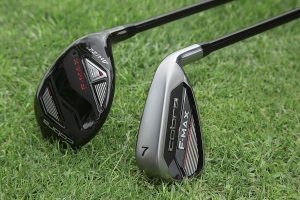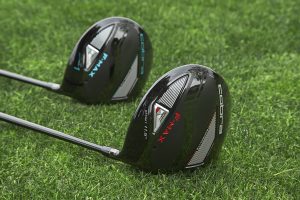Though I try to deny it, I’m getting older. And as much as I try to compensate for this biological fact, muscle tone and flexibility are slipping away little by little, too.
What does this mean for my golf game? Paradoxically, even though I’m scoring better than I ever have, I’m also hitting the ball about 10 yards shorter than just a few years ago, and 20-30 yards shorter than when I was in my 30s (when I only rarely broke 90).
Today’s golf equipment manufacturers are cognizant of golf demographics, and they have been producing clubs aimed at players with slower swing speeds and typical swing flaws – generally, slices – for a couple of decades. New innovations in materials and design are improving the effectiveness of these compensatory clubs, however.
Case in point, Cobra Golf’s F-MAX Superlite clubs. Cobra’s F-MAX line, which includes irons, hybrids, and woods, features ultra-light shafts, starting at just 40 grams, and matching ultra-light face and crown materials. Even the grips are the lightest that Cobra makes. All of these aim to help players amp up swing speeds.
To address the most frequent swing flaw, the push or slice, all clubheads are offset quite noticeably. This positioning of the face behind the shaft/hosel allows for just that much more time, and some help from physics, to get the face square before contact.
How the Cobra F-MAX hybrids and fairway woods play
Given the lamentation of my introduction, when I caught wind of the F-MAX clubs, I jumped at the chance to test them out. Recent years have brought nothing but pain and frustration with my fairway woods, so I tested a 16-degree 3-wood with a 55-gram stiff shaft ($199). And, because my beloved hybrid is the oldest club in my bag, I decided to try a 23-degree F-MAX 3-hybrid ($179) as well.
There is a caveat, however: I do not usually slice or push the ball. In fact, my miss tends to be a wicked hook. And I do usually try to avoid clubs with excessive offset, as they exacerbate hooks.
Long story short: I swung the F-MAX plenty fast – the lightness of the design did seem to really speed my swing. And the look, feel, and contact were outstanding. But every shot on the course swerved violently to the left. On the range, I was able to slow down my swing and work out the timing after awhile to subdue the right-to-left ball flight somewhat, but it required lots of reps.
Just to make sure my own swing flaws weren’t to blame, I asked my buddy Troy to give the F-MAX a whirl. Troy is a low-single-digit handicap and high-school golf coach in his early 40s who hits the ball a mile. “I love the look of these,” he said setting up. Then he proceeded to snap-hook a few shots in a row.
“Really solid,” he said. “But yeah, they aren’t made for our swings.”
So I went to another buddy, Jose. Jose is in his early 60s, is somewhat small of stature, just began golf a few years ago but already breaks 40 regularly for 9 holes. His miss is, wait for it, to the RIGHT.
“This is the first 3-wood I’ve been able to hit consistently straight and long,” Jose reported after his first round with the F-MAX. “I have never had a club for 200-yard shots, which I have a lot because I’m not long off the tee. This is that club.”
As for the hybrid, Jose found it consistent and solid, but “I don’t hit it any farther than my 4-iron, so it doesn’t really add to my arsenal.” (It should be noted that Jose is remarkably good with long irons for a new player.)
The verdict
For players suffering from the common confluent afflictions of slowing swing speed and push/slice ball flight, the Cobra F-MAX are definitely worth a test. They look brilliant and feel incredibly solid despite their featherweight design. But they are designed for and targe ted to players with these swing characteristics. If, like me, your miss is a hook – and a hook due to over-swinging at that – these clubs are likely not the medicine you need to cure your ills.


